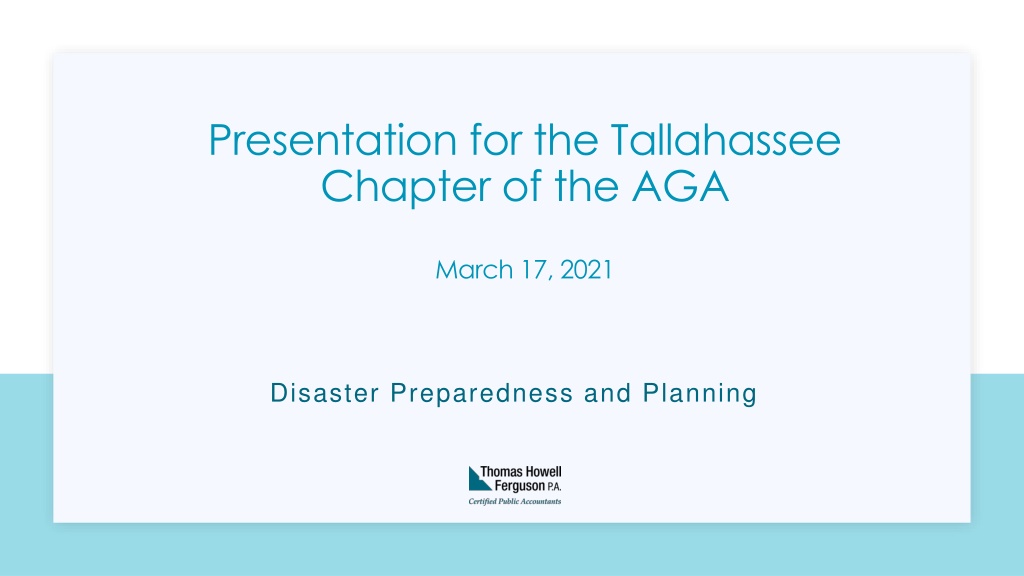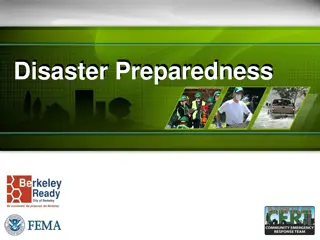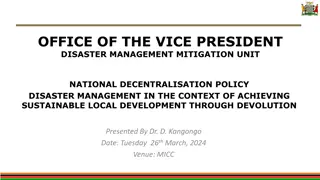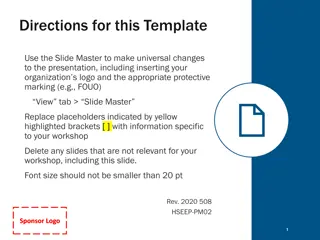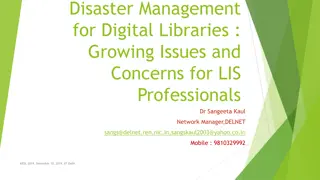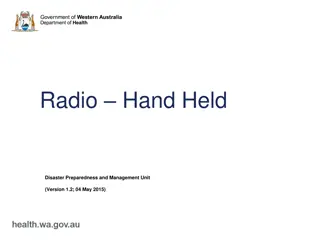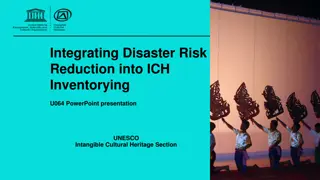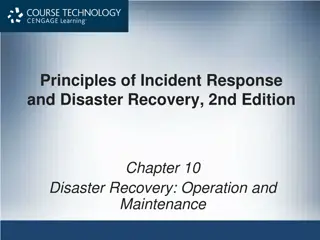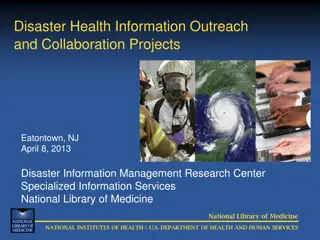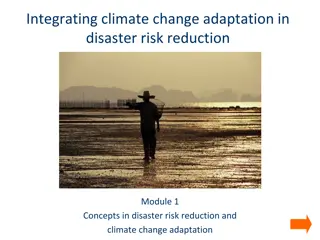Disaster Preparedness and Planning Presentation for Tallahassee Chapter of AGA
The presentation for the Tallahassee Chapter of AGA on Disaster Preparedness and Planning, conducted by Ben A. (Steve) Stevens III, CPA, Director of Assurance Services at Thomas Howell Ferguson P.A. CPAs, covers the National Preparedness Goal, Four Phases of Emergency Management, Mitigation, Preparedness, Response, and Recovery. It emphasizes the importance of being prepared collectively as a community, outlining steps for emergency planning and management to prevent, protect against, mitigate, respond to, and recover from potential threats and hazards effectively.
Download Presentation

Please find below an Image/Link to download the presentation.
The content on the website is provided AS IS for your information and personal use only. It may not be sold, licensed, or shared on other websites without obtaining consent from the author. Download presentation by click this link. If you encounter any issues during the download, it is possible that the publisher has removed the file from their server.
E N D
Presentation Transcript
Presentation for the Tallahassee Chapter of the AGA March 17, 2021 Disaster Preparedness and Planning
Ben A. (Steve) Stevens III, CPA Director, Assurance Services Thomas Howell Ferguson P.A. CPAs 2615 Centennial Blvd., Ste. 200 Tallahassee, FL 32308 sstevens@thf-cpa.com Office: 850.668.8100 Cell: 850.554.1034
Goal: Be Prepared I. Overview II. Four Phases of Emergency Management Emergency Planning Process PRESENTATION OUTLINE III. IV. Emergency Planning Process Steps Questions and Answers V.
I. OVERVIEW The National Preparedness Goal (the Goal) is [a] secure and resilient Nation with the capabilities required across the whole community to prevent, protect against, mitigate, respond to, and recover from the threats and hazards that pose the greatest risk. See Department of Homeland Security, National Preparedness Goal, Second Edition, 1 (Sept. 2015). The Goal essentially defines what it means for all communities to be prepared collectively for the threats and hazards that pose the greatest risk to the nation.
Mitigation Preparedness II. FOUR PHASES OF EMERGENCY MANAGEMENT Response Recovery
Includes any activities that prevent an emergency, reduce the chance of an emergency happening, or reduce the damaging effects of unavoidable emergencies. MITIGATION PREVENTING FUTURE EMERGENCIES OR MINIMIZING THEIR EFFECTS Buying flood and fire insurance for your home is a mitigation activity. Mitigation activities take place before and after emergencies.
Includes plans or preparations made to save lives and to help response and rescue operations. PREPAREDNESS Evacuation plans and stocking food and water are both examples of preparedness. PREPARING TO HANDLE AN EMERGENCY Preparedness activities take place before an emergency occurs.
Includes actions taken to save lives and prevent further property damage in an emergency situation. Response is putting your preparedness plans into action. RESPONSE Seeking shelter from a tornado or turning off gas valves in an earthquake are both response activities. RESPONDING SAFELY TO AN EMERGENCY Response activities take place during an emergency.
Includes actions taken to return to a normal or an even safer situation following an emergency. RECOVERY Recovery includes getting financial assistance to help pay for the repairs. RECOVERING FROM AN EMERGENCY Recovery activities take place after an emergency.
The emergency planning process is successful when all parties involved understand their responsibilities. Federal III. EMERGENCY PLANNING PROCESS State Local
Federal Responsibilities At the Federal level of government, the Federal Emergency Management Agency (FEMA) is involved in mitigation, preparedness, response, and recovery activities. FEMA helps the states in several ways. FEMA provides the following programs: Training programs and research information on the latest mitigation measures; Review and coordination of State emergency plans; Financial assistance; Flood insurance to individuals and businesses in communities that join the National Flood Insurance Program (NFIP); Subsidies to State and local offices of emergency management for maintaining emergency management programs; Guidance and coordination for plans to warn and protect the nation in national security emergencies; and Coordination of services for disaster response and recovery activities. III. EMERGENCY PLANNING PROCESS
State Responsibilities The State emergency management office is responsible for protecting communities and citizens within the state. The State office carries out statewide emergency management activities and: Helps coordinate emergency management activities involving more than one community. Assists individual communities when they need help. Helps with money, personnel, or other resources. III. EMERGENCY PLANNING PROCESS
State Responsibilities (continued) The Governor reviews the local government s application, studies the damage estimates and, if appropriate, declares the area a State disaster. This official declaration makes State resources available. However, if damages are so extensive that the combined local and State resources are not sufficient, the Governor applies to the President for Federal disaster assistance. III. EMERGENCY PLANNING PROCESS If the need for Federal assistance funds is justified, the President issues a major disaster declaration and Federal resources are made available.
Local Government Responsibilities Identifying hazards and assessing their potential risk to the community. Determining the community s capability to mitigate against, prepare for, respond to, and recover from major emergencies. III. EMERGENCY PLANNING PROCESS Identifying and employing methods to improve the community s emergency management capability through efficient use of resources, improved coordination, and cooperation with other communities and with the State and Federal governments. Establishing mitigation measures such as building codes, zoning ordinances, or land-use management programs.
Local Government Responsibilities (continued) Developing and coordinating preparedness plans. Establishing warning systems. Stocking emergency supplies and equipment. Educating the public and training emergency personnel. Assessing damage caused by the emergency. Activating response plans and rescue operations. Ensuring that shelter and medical assistance are provided. Recovering from the emergency and helping citizens return to normal life as soon as possible. III. EMERGENCY PLANNING PROCESS
IV. EMERGENCY PLANNING PROCESS STEPS STEP 1. FORM A COLLABORATIVE PLANNING TEAM STEP 2. SITUATIONAL AWARENESS STEP 3. STEP 4. STEP 5. STEP 6. PLAN DETERMINE GOALS AND OBJECTIVES PLAN DEVELOPMENT PLAN PREPARATION, REVIEW, AND APPROVAL IMPLEMENTATION AND MAINTENANCE
IV. EMERGENCY PLANNING PROCESS STEPS Form Form a Collaborative Planning Team Identify Identify the Core Planning Team: Emergency Management, Finance, Legal, Law Enforcement, Utilities, Infrastructure, etc. Engage Engage the Community: Business Chambers, Volunteer Organizations like the Red Cross, Municipality Leaders, etc.
IV. EMERGENCY PLANNING PROCESS STEPS Situational Awareness Identify Threats and Hazards Assess Risk
IV. EMERGENCY PLANNING PROCESS STEPS Hazards - Natural Meteorological - Flooding, Dam/Levee Failure, Severe Thunderstorm (Wind, Rain, Lightning, Hail), Tornado, Windstorm, Hurricanes and Tropical Storms, Winter Storm (Snow/Ice) Geological - Earthquake, Tsunami, Landslide, Subsidence/Sinkhole, Volcano Biological - Pandemic Disease, Foodborne Illnesses
Hazards Caused by Humans IV. EMERGENCY PLANNING PROCESS STEPS Accidents - Workplace Accidents, Entrapment/Rescue (Machinery, Water, Confined Space, High Angle), Transportation Accidents (Motor Vehicle, Rail, Water, Air, Pipeline), Structural Failure/Collapse, Mechanical Breakdown Intentional Acts - Labor Strike, Demonstrations, Civil Disturbance (Riot), Bomb Threat, Lost/Separated Person, Child Abduction, Kidnapping/Extortion, Hostage Incident, Workplace Violence, Robbery, Sniper Incident, Terrorism (Chemical, Biological, Radiological, Nuclear, Explosives), Arson, Cyber/Information Technology (Malware Attack, Hacking, Fraud, Denial of Service, etc.)
Hazards - Technological IV. EMERGENCY PLANNING PROCESS STEPS Information Technology - Loss of Connectivity, Hardware Failure, Lost/Corrupted Data, Application Failure Utility Outage - Communications, Electrical Power, Water, Gas, Steam, Heating/Ventilation/Air Conditioning, Pollution Control System, Sewage System Fire/Explosion - Fire (Structure, Wildland), Explosion (Chemical, Gas, or Process Failure) Hazardous Materials - Hazardous Material Spill/Release, Radiological Accident, Hazmat Incident Off-site, Transportation Accidents, Nuclear Power Plant Incident, Natural Gas Leak Supply Chain Interruption - Supplier Failure, Transportation Interruption
IV. EMERGENCY PLANNING PROCESS STEPS Determine Operational Priorities Set Goals and Objectives
IV. EMERGENCY PLANNING PROCESS STEPS Determine Operational Priorities Use information from the risk profile developed as part of the analysis process. The planning team engages the senior official to establish how the hazard or threat would evolve in the jurisdiction and what defines a successful outcome for responders, disaster survivors, and the community.
IV. EMERGENCY PLANNING PROCESS STEPS Set Goals and Objectives Goals and objectives must be carefully crafted to ensure they support accomplishing the plan mission and operational priorities. They must also clearly indicate the desired result or end- state they are designed to yield.
IV. EMERGENCY PLANNING PROCESS STEPS Plan Development Develop and Analyze Courses of Action Identify Resources Identify Information and Intelligence Needs
Plan Plan Preparation, Review, and Approval IV. EMERGENCY PLANNING PROCESS STEPS Draft Draft the written plan Review Review the plan Approve and Disseminate Approve and Disseminate the Plan
Plan Implementation and Maintenance IV. EMERGENCY PLANNING PROCESS STEPS Training Practice and Exercise of the Plan Review and Revise the Plan Maintain the Plan
References https://www.fema.gov/sites/default/files/2020- 07/developing-maintaining-emergency-operations- plans.pdf https://www.fema.gov/emergency-managers/national- preparedness/frameworks/recovery https://www.fema.gov/sites/default/files/2020- 04/CPG201Final20180525.pdf https://www.fema.gov/sites/default/files/2020- 06/fema_public-assistance-program-and-policy- guide_v4_6-1-2020.pdf https://www.ecfr.gov/cgi-bin/text- idx?tpl=/ecfrbrowse/Title02/2cfr200_main_02.tpl
Ben A. (Steve) Stevens III, CPA Director, Assurance Services Thomas Howell Ferguson P.A. CPAs 2615 Centennial Blvd., Ste. 200 Tallahassee, FL 32308 sstevens@thf-cpa.com Office: 850.668.8100 Cell: 850.554.1034
